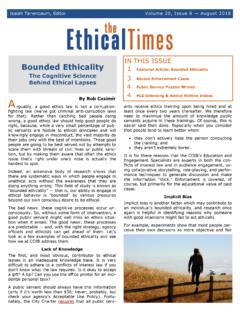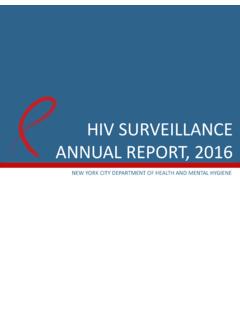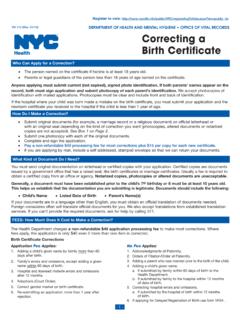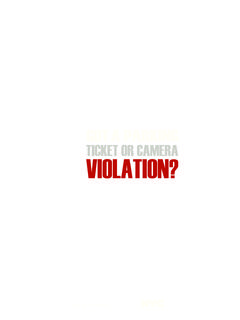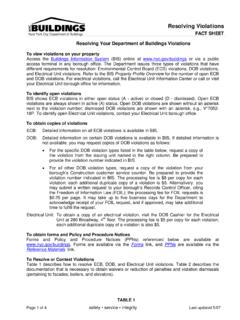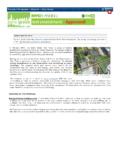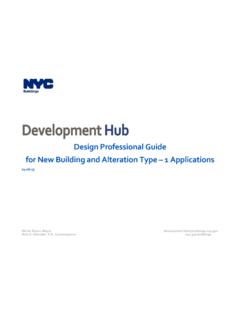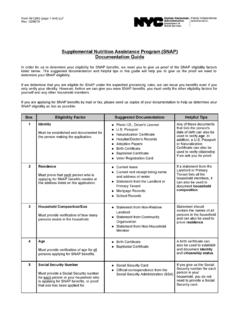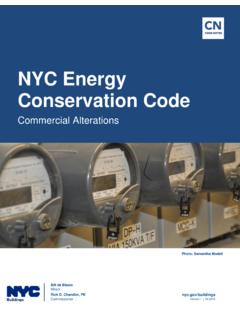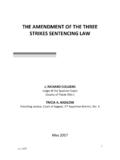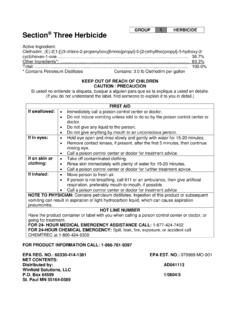Transcription of YEAR THREE REPORT - New York City
1 year THREE REPORT . February 2017. No goal is more ambitious than zero, but at the same time no other goal is acceptable. We have accomplished a lot in the first THREE years of Vision Zero, but we will not rest until we have accomplished that ultimate goal. Mayor Bill de Blasio VISION ZERO year THREE REPORT 3. Table of Contents Vision Zero year THREE 4 Executive Summary 8 Vision Zero By the Numbers 10 STATISTICS AND METRICS. Traffic Fatalities in 2016. 17 DATA-DRIVEN SOLUTIONS. Cross-Agency Evaluation and Data-Driven Collaboration 24 ENGINEERING. Designs to Protect the Most Vulnerable Users 38 ENFORCEMENT. Focus on the Prevention of Serious Crashes 48 FLEETS.
2 Expanded Technology for Safer city Vehicles 57 ENGAGEMENT. Connecting with New Yorkers Where They Live Vision Zero year Four 66 Vision Zero year Four Initiatives Appendix 69 year One Scorecard 72 year Two Scorecard 74 year THREE Scorecard 75 Glossary 77 Helpful Links 78 Task Force Members 4 VISION ZERO year THREE REPORT . Vision Zero year THREE Executive Summary 2016 had the fewest traffic fatalities on record, improving on a record year in 2015. The first THREE years of Vision Zero is the safest THREE - year period in New york city 's history. Vision Zero's progress in preventing serious crashes is encouraging, because it indicates that the city 's strategy is working.
3 However, even in the city 's safest year there was a fatal crash every 38 hours. New Yorkers are still losing their lives in traffic crashes, and their families and neighbors must grapple with the grief caused by sudden loss. Much remains to be done in order to reach Mayor de Blasio's goal of zero deaths. The following pages summarize the city 's progress to date and introduce new initiatives that build on the accomplishments of Vision Zero's first THREE years. The city will continue to refine its strategies and develop new tactics in order to accelerate progress towards eliminating fatalities and serious injuries on city streets. Statistics and Metrics // year THREE Priority Corridors, Intersections and Areas In 2015, New york city Department of Transportation (DOT) and New york Police Department (NYPD) outlined a strategy in the Borough Pedestrian Safety Action Plans, concentrating street redesign, enforcement, education and engagement resources on the most high-crash corridors and intersections in each borough.
4 This effort is proving effective. Declines in traffic fatalities at these locations are outpacing the citywide decline in traffic deaths. For the five years prior to Vision Zero there were 141 deaths annually at Vision Zero priority locations; this year , there were 100 fatalities, a 29 percent decline. For pedestrians, there was a similar decline: from an average of 99 fatalities a year from 2009-2013 at such locations to 72 in 2016, 27 percent lower. VISION ZERO year THREE REPORT 5. Data-Driven Solutions // year THREE Cross-Agency Evaluation and Data-Driven Collaboration The Department of Health and Mental Hygiene (DOHMH) proposed and coordinated October 2016's Research on the Road event, which provided over 40 external researchers the opportunity to connect with the agencies that lead the Vision Zero Task Force.
5 The event generated a productive discussion about shared research priorities across all agencies and research institutions. DOHMH also advanced the Data Linkage project, which provides preliminary analysis of injury patterns associated with crash types and insight into the factors that must be prioritized to achieve Vision Zero. In 2016, DOT and NYPD conducted an analysis of crash trends and found that the earlier onset of darkness in the fall and winter is correlated with a 40 percent increase in fatal and severe injury crashes involving pedestrians in the early evening hours, as compared to those same hours outside fall and winter. In response, the Vision Zero Task Force developed a multi-agency enforcement and education strategy that increased evening and nighttime enforcement by NYPD officers and Taxi and Limousine Commission (TLC) inspectors, as well as a targeted education campaign that combined on-street engagement and messages on television and drive-time radio to encourage safer driver behavior during these key hours.
6 Traffic fatalities during the initiative declined by 30 percent, an encouraging result. 6 VISION ZERO year THREE REPORT . Engineering // year THREE Designs to Protect the Most Vulnerable Users Since the beginning of Vision Zero, DOT has completed 242 Safety Engineering Projects. These redesigns make New Yorkers safer by simplifying complex in- tersections, narrowing lanes, adding bicycle paths, making pedestrians and cyclists more visible, and shortening pedestrian crossing distances. In 2016, DOT implemented 105 of these Safety Engineering Projects more than ever before, and at more than double the pace of implementation prior to Vision Zero. Notably, in 2016 a record-breaking miles of protected bike lanes were installed, triple the number DOT installed prior to Vision Zero.
7 Addition- ally, DOT installed 776 Leading Pedestrian Intervals (LPIs), bringing the total completed under Vision Zero to 1,248 nearly 5 times the number of LPIs that existed in New york prior to Vision Zero. In 2016, DOT also launched the Left Turn Traffic Calming pilot at 107 locations across the city . These treatments have proven effective at reducing median left turn speeds by 24 percent, which will make pedestrians safer at those locations. Enforcement // year THREE Combatting Dangerous Driving Behavior NYPD's focus on consistent and predictable enforcement deters reckless driving, prevents crashes, and saves lives. Indeed, 60 percent of all traffic violations that NYPD issued in 2016 were for Vision Zero hazardous violations.
8 NYPD officers issued over 137,000 speeding summonses in 2016, a 78. percent increase over the five year average prior to Vision Zero. Over 42,000. summonses were issued to motorists who failed to yield to pedestrians in the crosswalk, an increase of 243 percent over the five year average prior to Vision Zero. In addition, NYPD officers issued over 1,900 summonses and made 39. arrests of drivers who struck a pedestrian or cyclist in violation of the Right of Way law. VISION ZERO year THREE REPORT 7. Fleets // year THREE Expanded Technology for Safer city Vehicles The largest fleets in the city are: the for-hire vehicle sector, which is regulated by TLC; the city 's government vehicle fleet, which is regulated in part by the Department of Citywide Administrative Services (DCAS); and the public buses, which are operated by the Metropolitan Transit Authority (MTA).
9 All THREE of these agencies are preventing serious crashes by strengthening their drivers' skills through enhanced Vision Zero training regimens, which includes a segment featuring members of Families for Safe Streets talking about the devastating loss of loved ones in traffic crashes. These THREE agencies have trained over 70,000 vehicle operators since the beginning of Vision Zero. After extensive research, TLC developed rules to prevent for-hire vehicle operators from driving while excessively fatigued. DCAS, after conducting extensive research about distracted driving, developed and announced a policy prohibiting city employees from using any cell phones, even with a hands-free set.
10 MTA expanded their pilot of collision avoidance sensor and pedestrian alert technologies to prevent serious crashes, and will expand it further in 2017. Engagement // year THREE Connecting with New Yorkers Where They Live In September 2016, the Department of Education announced the development and implementation of the Cross This Way curriculum for elementary and middle school students. This curriculum was informed by data analysis performed by DOT, and teaches children about the risks posed by reckless driving and ways to help protect themselves. The Task Force also expanded the Vision Zero ad campaign in 2016, increased the visibility of the campaign and targeted the ads according to crash data, DOHMH surveys, and other data.
